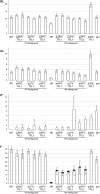Changing the spatial pattern of TFL1 expression reveals its key role in the shoot meristem in controlling Arabidopsis flowering architecture
- PMID: 26019254
- PMCID: PMC4507777
- DOI: 10.1093/jxb/erv247
Changing the spatial pattern of TFL1 expression reveals its key role in the shoot meristem in controlling Arabidopsis flowering architecture
Abstract
Models for the control of above-ground plant architectures show how meristems can be programmed to be either shoots or flowers. Molecular, genetic, transgenic, and mathematical studies have greatly refined these models, suggesting that the phase of the shoot reflects different genes contributing to its repression of flowering, its vegetativeness ('veg'), before activators promote flower development. Key elements of how the repressor of flowering and shoot meristem gene TFL1 acts have now been tested, by changing its spatiotemporal pattern. It is shown that TFL1 can act outside of its normal expression domain in leaf primordia or floral meristems to repress flower identity. These data show how the timing and spatial pattern of TFL1 expression affect overall plant architecture. This reveals that the underlying pattern of TFL1 interactors is complex and that they may be spatially more widespread than TFL1 itself, which is confined to shoots. However, the data show that while TFL1 and floral genes can both act and compete in the same meristem, it appears that the main shoot meristem is more sensitive to TFL1 rather than floral genes. This spatial analysis therefore reveals how a difference in response helps maintain the 'veg' state of the shoot meristem.
Keywords: Architecture; TFL1.; expression; flowering; identity; meristem.
© The Author 2015. Published by Oxford University Press on behalf of the Society for Experimental Biology.
Figures






References
-
- Abe M, Kobayashi Y, Yamamoto S, Daimon Y, Yamaguchi A, Ikeda Y, Ichinoki H, Notaguchi M, Goto K, Araki T. 2005. FD, a bZIP protein mediating signals from the floral pathway integrator FT at the shoot apex. Science 309, 1052–1056. - PubMed
-
- Alonso-Blanco C, Mendez-Vigo D. 2014. Genetic architecture of naturally occurring quantitative traits in plants: and updated synthesis. Current Opinion in Plant Biology 18, 37–43. - PubMed
-
- Alvarez J, Guli CL, Yu X-H, Smyth DR. 1992. terminal flower: a gene affecting inflorescence development in Arabidopsis thaliana . The Plant Journal 2, 103–116.
-
- Andres F, Coupland G. 2012. The genetic basis of flowering responses to seasonal cues. Nature Reviews Genetics 13, 627–639. - PubMed
Publication types
MeSH terms
Substances
LinkOut - more resources
Full Text Sources
Other Literature Sources
Molecular Biology Databases

